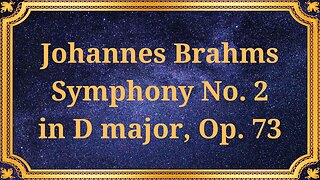Premium Only Content

Wolfgang Amadeus Mozart Symphony No17 In G Major K 129
#Mozart#Chamber_music#Classical_music#Symphony#Musical_composition
Publication date 1953
Louis Kaufman, Violinist
Netherlands Philharmonic Orchestra
Otto Ackermann, Conductor
Wolfgang Amadeus Mozart Symphony No. 17 in G major, K. 129, is a beautiful and uplifting piece of classical music that was composed by the legendary Austrian composer, Wolfgang Amadeus Mozart. This symphony is one of the lesser-known works of Mozart and was composed in Salzburg in 1772 when he was just 16 years old.
The Symphony No. 17 is scored for two oboes, two horns, and strings. It is in three movements, with the first and last movements in the key of G major, while the second movement is in E-flat major. The symphony is known for its graceful melodies, balanced structure, and clear harmonies.
The first movement of the symphony, marked "Allegro," is a lively and joyful piece that showcases Mozart's talent for creating beautiful and memorable melodies. The opening theme is introduced by the strings and is then repeated by the oboes and horns. The development section of the movement features a beautiful solo passage for the first violin.
The second movement, marked "Andante," is a slower and more contemplative piece that features a beautiful and expressive melody played by the first violin. The movement is in E-flat major, a key that Mozart often used to convey a sense of melancholy and introspection.
The final movement, marked "Allegro," is a playful and energetic piece that brings the symphony to a lively conclusion. The movement features rapid-fire rhythms and virtuosic solo passages for the oboes and horns.
Overall, the Symphony No. 17 is an excellent example of Mozart's early style, characterized by graceful melodies, balanced structure, and clear harmonies. The symphony is also a testament to Mozart's prodigious talent, as he was able to compose such a masterpiece at such a young age.
In terms of its historical context, the Symphony No. 17 was composed during a time of great innovation and experimentation in classical music. The symphony is often classified as belonging to the "Mannheim School," a group of composers who were known for their use of dynamic contrasts, expressive melodies, and virtuosic solo passages.
In conclusion, Wolfgang Amadeus Mozart's Symphony No. 17 in G major, K. 129, is a masterpiece of classical music that showcases Mozart's prodigious talent and early style. Its graceful melodies, balanced structure, and clear harmonies make it a must-listen for any lover of classical music.
-
 36:10
36:10
Classical music_Music Inspiration
1 month agoJohannes Brahms Symphony No. 2 in D major, Op. 73
561 -
 LIVE
LIVE
Dr Disrespect
2 hours ago🔴LIVE - DR DISRESPECT - TOP 10 HOTTEST DEMOS OF 2025
1,790 watching -
 DVR
DVR
Sean Unpaved
1 hour agoFandom Fights Back: Ace Bailey & the Athlete-Fan Divide
4.81K -
 LIVE
LIVE
StoneMountain64
1 hour agoIt's Rocket League but with HUMANS. This should be a sport.
360 watching -
 16:14
16:14
IsaacButterfield
9 hours ago $0.18 earnedLiver King Arrested For Threatening Joe Rogan
8311 -
 2:09:29
2:09:29
Tim Pool
3 hours agoEXPOSING Secret Government Tech, UFOs & TELEPORTATION | The Culture War with Tim Pool
218K79 -
 2:03:06
2:03:06
The Charlie Kirk Show
2 hours agoDouble SCOTUS Victory + AMA | Mailman, Sen. Mullin | 6.27.25
38.3K12 -
 1:04:38
1:04:38
The Big Mig™
2 hours agoGlobal Finance Forum From Bullion To Borders We Cover It All
4.3K9 -
 1:12:32
1:12:32
Rebel News
1 hour agoGazan refugees to Canada, Canadian dies in ICE custody, Pro-Iran protests in Toronto | Rebel Roundup
5.3K8 -
 35:23
35:23
Tudor Dixon
1 hour agoThe China Factor: What They’re Not Telling Us About 2020 with John Solomon | The Tudor Dixon Podcast
4.52K